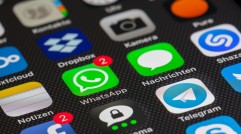Watches and Wristbands Galore At CES 2014: Coming to a Store Near You?
As expected, a big theme in this year's Consumer Electronics Show was wearables -- particularly watches and wristbands -- trying to enter the mainstream. What were niche gadgets or curiosities for early adopters in 2013 are now poised to come to a store near you, if they can convince critics and the general public of their mainstream appeal now.
CES 2014 saw probably the largest number, and range, of wearable computing devices in the Las Vegas show's history. Some went for a high fashion angle, while others are trying to prove their everyday usefulness and still others continued to display that they can do just a few things, but do them really well. Here's a rundown of the top wearable gadgets on the showroom floor this year.
Fitness
Fitness trackers have had an early start in the wearable market, because they have an immediate advantage over smartphones and other devices: they're small, durable, always on, and useful to those who have obsessively sought to track themselves long before the "Quantified Self" became a thing.
Among the popular fitness trackers at CES, there were newcomers seeking to snare some users away from the likes of Fitbit and the Nike FuelBand. Those included the "Reign" by Jaybird, which will be "available in time for your 2014 summer workout," the LG Lifeband Touch, which includes notifications and music on its slim touchscreen, and the Razer Nabu (from the Razer gaming company), which seeks to go beyond workouts and "gamify any activity" by giving you "points" towards unlocking achievements for positive activities.
A few other "fitness wearables" defied convention while offering a smart fitness experience of some sort or another. The Tao Wellshell, for example, looks like an oversized hockey puck and is touted as a "gym in your pocket." Users squeeze the shell in their hands or other part of the body, and it tracks the pressure, as well as the user's heart rate. The strange device also includes a GPS tracker, pedometer, and can measure a user's sleep quality and length.
The LUMOback, meanwhile, is a small chip that monitors your posture and vibrates to remind you to sit up straight, with your shoulders back. This electronic equivalent of a forbidding English nanny is coming to market in Spring 2014.
Watches Galore
While Pebble, one of the first smartwatch companies, announced the Pebble Steel, the same smartwatch but with a steel construction and a black matte or brushed metal finish, seemingly every device maker besides Google and Apple announced or displayed their smartwatch at CES 2014.
Qualcomm showed off its Toq smartwatch and announced a special $50 off sale for the duration of CES, and smaller companies like Burg, Cogito, Cookoo, MyKronoz, Sonostar, Metawatch, and Neptune all introduced variations on the smartwatch theme. Even Epison -- better known for its infuriating printers -- is expected to show off a smartwatch at CES, along with its Moverio smart glasses.
Perhaps the most interesting smartwatch at CES sought a smaller, yet untapped, crowd with a smartwatch with purposely-limited functionality. The FiLIP smartwatch is aimed at parents of young children who don't need -- or want -- their kids to have a full-on smartphone, but want to keep in close contact. The FiLIP, available in four kid-friendly colors, is durable, water resistant, tracks where the kid is, and provides limited one-touch calls to and from an approved list of contacts. It's available as of late November 2013 and cheap (for a smartwatch).
2014: The First Year of Wearable Tech?
With the global wearable market already at nearly $10 billion by the end of 2013, and according to research firm IHS, set to grow to over $30 billion by 2018, expect to see a battle of smartwatches and wristbands this year, reminiscent of the MP3-player explosion in the early 2000s. And who knows, by the end of 2014, you just might have bought one.
Subscribe to Latin Post!
Sign up for our free newsletter for the Latest coverage!














